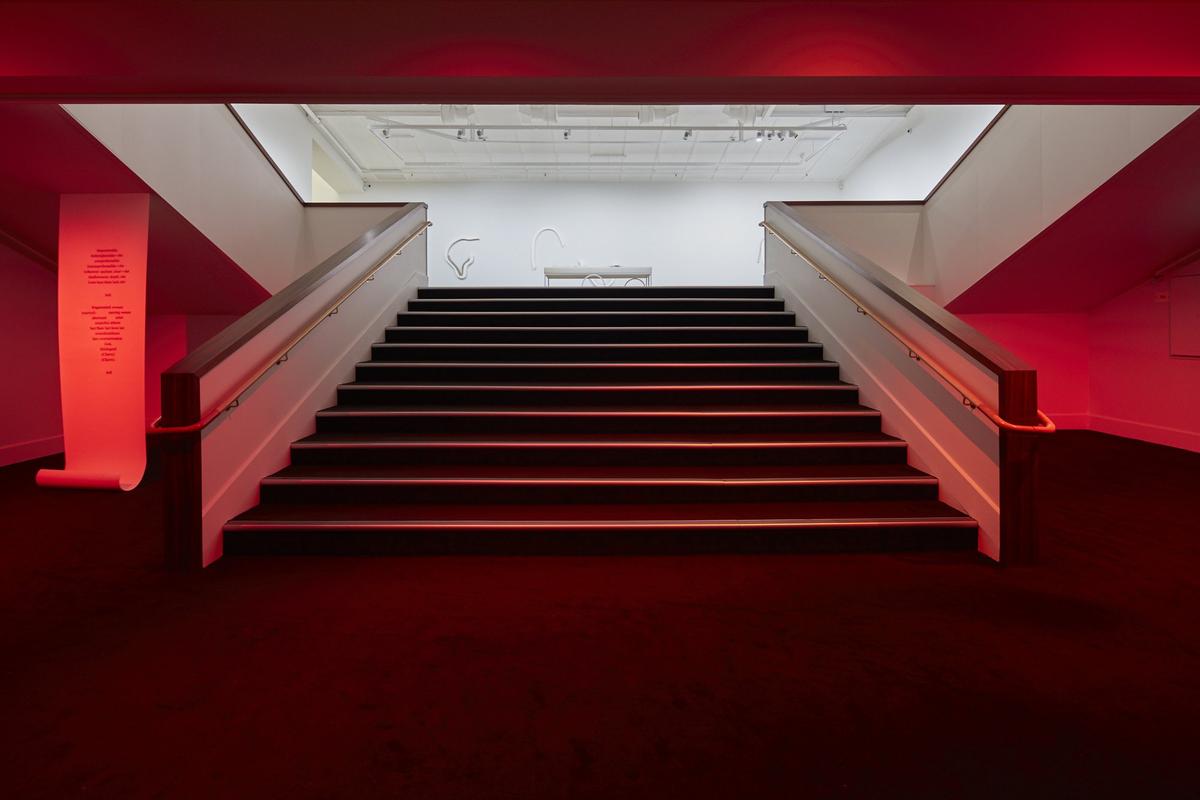A warning, perhaps, for reviewers. On the second floor of the Govett Brewster large sheets of paper are lit by vivid red lights. In the gloom, we can make out semi-deconstructed poems and brief statements: coherent, unclear, clear – she / shallowness-depth-she / Less-less-than lack-she. The artwork is Bad Review (2018), and in it Sriwhana Spong has taken a review of her 2018 exhibition at the Pump House Gallery in London and cut it up, expanded and spliced it, and inserted her own words. Spong’s interventions suggest that text is not static, and that the judgments drawn by a reviewer can be reworked, questioned, and unpicked.
Language and its implicit power structures are one of the themes of a hook but no fish. The exhibition circles around the figure of Hildegard von Bingen, a German twelfth-century nun who was accomplished in numerous fields: she was a prolific composer, botanist, writer, philosopher, and theologist. Born in the small town of Böckelheim near the Rhine, when she was eight Hildegard was enclosed at a convent at Disibodenberg, where she was educated by Jutta, a religious recluse. In 1150 Hildegard established her own convent at Rupertsberg, and then another later at Eibingen in 1163. She was a leader and a polymath, intensely curious about the world, and also, beginning at a young age, she saw visions, which she was encouraged to record and subsequently published in the form of Scivias, the first of three volumes about her prophecies.
As a gifted and creative woman in the male dominated world of the medieval Catholic Church, Hildegard was an anomaly in her time, and after centuries of neglect, the recent growth in feminist scholarship has seen interest in her life and work increase. In 2012 Pope Benedict XVI officially recognised Hildegard as a Saint and artists, writers, academics, and musicians have been inspired by her work.
For Spong, the Lingua Ignota, a language Hildegard created, has been of particular interest. The title of this exhibition, a hook but no fish, refers to the fact that the Lingua was incomplete (it included a word for hook, but not one for fish), and its purpose remains unclear. No one knows whether, in fact, anyone else apart from Hildegard learnt or could speak it. Spong’s titular video work opens with shots of the leafy ruins of Disibodenburg. Later, we see images of a woman shrouded in a nun-like plastic veil and words run along the bottom of the screen: In H’s glossary there is a word for fishhook but no word for fish. There is a word for plough but none for an ox or horse—so nothing to pull it. There is no word for sea or for river, so nothing to caress the hook. The video work asks: Was this a prophetic language? Was the language inspired by a future that Hildegard saw in her visions? In the final minutes of the work we see a crowd of pigeons bustling for food, an injured cat, and herons stalking through a litter-strewn city, accompanied by a dream-like, choral-inflected soundtrack by Claire Duncan. What does this mean? In a hook but no fish Spong brings together images of decay, and death, and life, and sustenance, the meaning of which drifts, and, I think, is inspired by the way narrative is constructed in the female writers and mystics that Spong has found so generative for her art-making.(1) “I think of women’s time as continuous,” Spong said in her conversation with Govett Brewster curator Tendai John Mutambu at the exhibition’s opening weekend, and this is evident in a hook but no fish, which rejects the conventions of introduction, climax, and dénouement, but instead depicts sequences and networks; images flowing into other images.
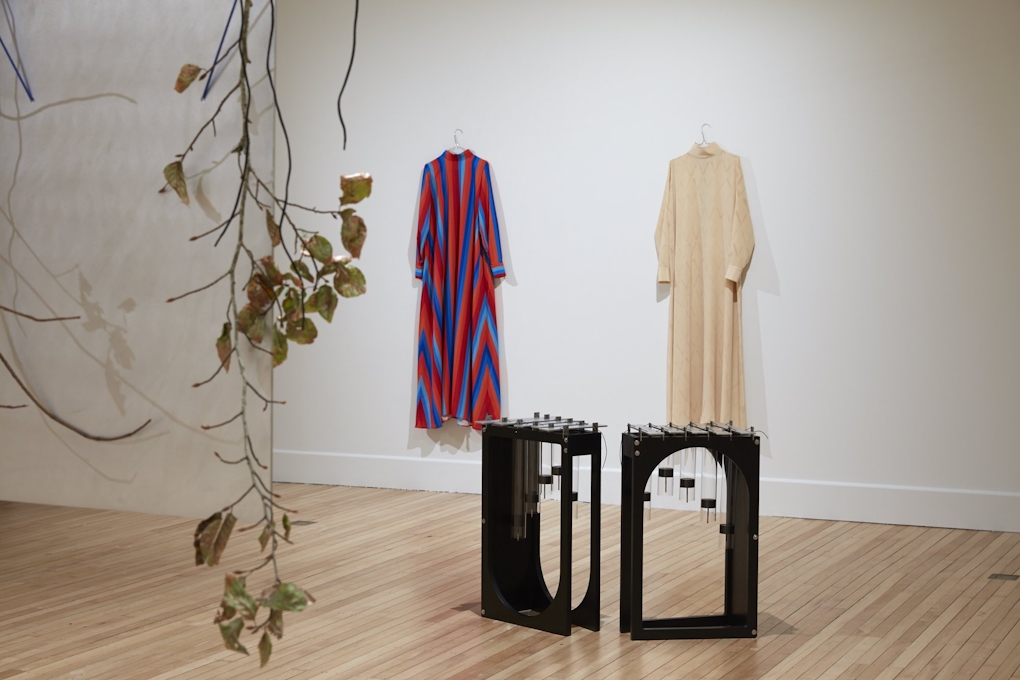
Installation view of a hook but no fish (2018) Sriwhana Spong, Govett-Brewster Art Gallery. Photo by Sam Hartnett
Spong describes Hildegard as having “curiosity [that] couldn’t be contained by a particular medium” and similarly, this exhibition leaps across different materials: two video works; sculptures of paraffin wax, wood, and clay; aluminum instruments; cut up text on paper; silk dyed in Coca-Cola, and vegetable oil; and paintings created in tartrazine pigment, water, honey, saffron, and gum Arabic.(2) As you ascend the stairs at the Govett Brewster, each level reveals artwork in an entirely new medium. There are few formal cues you can follow, but colour connects and links across the levels. The yellow plastic covering the entrance on the ground floor is repeated in the bright watercolour paintings upstairs, Sigil Design (Rothschild’s mynah) #9–#24 (2017–ongoing). The red light that illuminates Bad Review is seen again in the filters that overlay scenes in a hook but no fish (2017). This use of light and colour made me think of the Govett Brewster’s history as a movie theatre and the projection and illumination of film in this building, as well as the inaugural exhibition in the gallery, a sound and light installation by Leon Narbey.
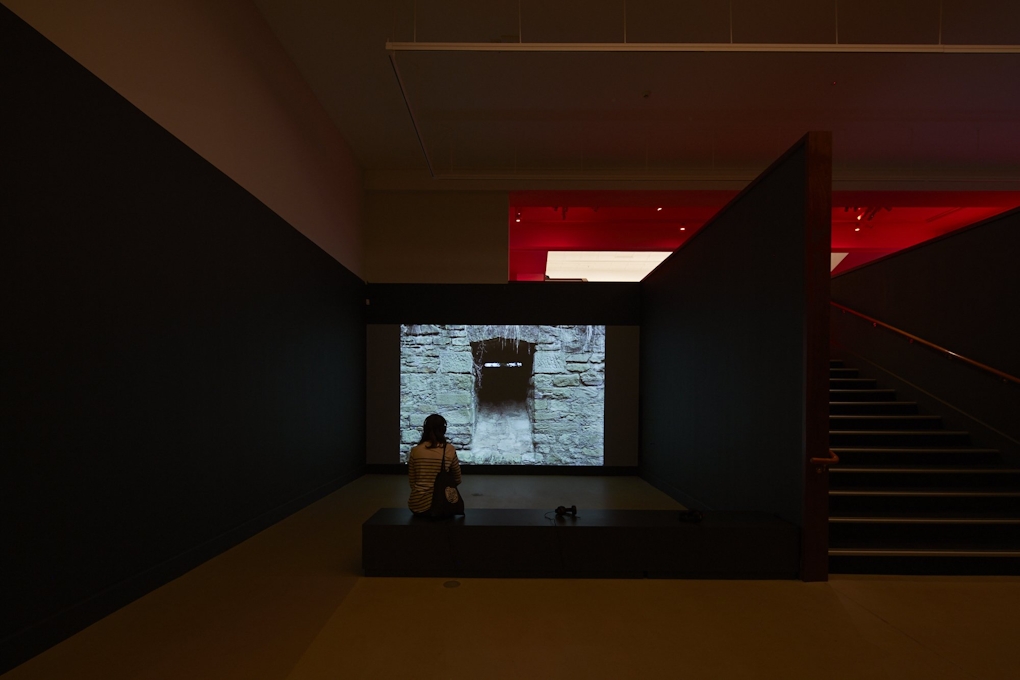
Installation view of a hook but no fish (2018) Sriwhana Spong, Govett-Brewster Art Gallery. Photo by Sam Hartnett
Beyond the use of colour, connections between the artworks are often difficult to draw. The model of the contemporary exhibition is implicitly predicated on the idea of relationships—both material and conceptual—across work, between artists, or ideas. We expect a major theme or a sequence of ideas that will act as the foundation of an exhibition. The current prominence of the role of the contemporary art curator underscores this expectation; the omnipotent author who is responsible for making meaning, or revealing for the audience the coherence of a body of artwork. Spong, however, seems to question this approach and deliberately disrupt it. a hook but no fish is intentional in its multiplicity, both in the material used to make the art and the breadth of the artist’s historical and artistic research. Spong has commented, “There’s this saying, ‘a jack of all trades, but a master of none’, and I sometimes feel like that…but then I think, I’m very anti the idea of being a master. For me, it’s much more interesting to be fluid between different mediums, and ways of making.”(3)
Much of the work in this exhibition was first exhibited at London’s Pump House Gallery in 2018, and at the Govett, Spong has added a number of pieces, made during her two-month residency in New Plymouth. This contributes to the sense of ideas accumulating and expanding, and of the exhibition gaining momentum across different galleries—again, this idea of continuity and sequences, rather than the exhibition as an end point, or a discrete event.
Spong’s polyphony also challenges the writing of a review of this exhibition. I want these paragraphs to link, to relate, and for this piece to follow a logical trajectory towards an insightful conclusion, but am aware of Spong’s disruption of this teleology. Where to next, then, dear reader?
The soundtracks of the two ground-floor video works are detailed and cinematic, and this interest in the sensual potential of sound is one thread that I can tentatively propose, as Spong has also created several instruments that are played during the course of the exhibition. On the top floor gallery we find a metallophone, Instrument C (Vivian), (2016); a bell plate, surrounded by branches and foliage, Instrument B (Claire), (2018); and a set of chimes that are aluminum casts of French fries, (Instrument D (Vera) (2018). Spong, who is of both New Zealand and Balinese heritage, has, in previous work, explored the aesthetics and materials of Balinese ritual.(4) Here, the metallophone is tuned in the same way as that of the gamelan, an ensemble of percussive instruments traditional to the islands of Bali and Java. The instruments were played together by guest musicians (Auckland band The Coolies) on the opening night, and again on the following day in an event where Spong also performed. The instruments were played without notation, the three musicians moving around each other, each taking turns to play the trio of artworks. Having seen a gamelan orchestra perform live several times, perhaps my expectations were misplaced, but I didn’t find the performances aurally interesting despite usually enjoying The Coolies’ music. The metallophone sounded dull, and the chimes were not adequately amplified; if they had produced more sound, they would have offset the gong-like resonance of the bell plate and provided a glistening treble to the lower registers of the other two instruments. However, the activation of these artworks as functional instruments was not confined to the performances but continues through the duration of the exhibition. The gallery invigilators hit the bell plate, Instrument C (Claire), every hour of the day, as determined by a score written in paper and honey on the gallery wall, which combines a hymn by Hildegard and the opening hours of the Govett Brewster Art Gallery. Imagine it: the galleries on a quiet Wednesday afternoon interrupted by the deep, reverberant gong of the bell plate; reminiscent of Hildegard’s nuns at Rupertsberg solemnly being called through the corridors to prayer.
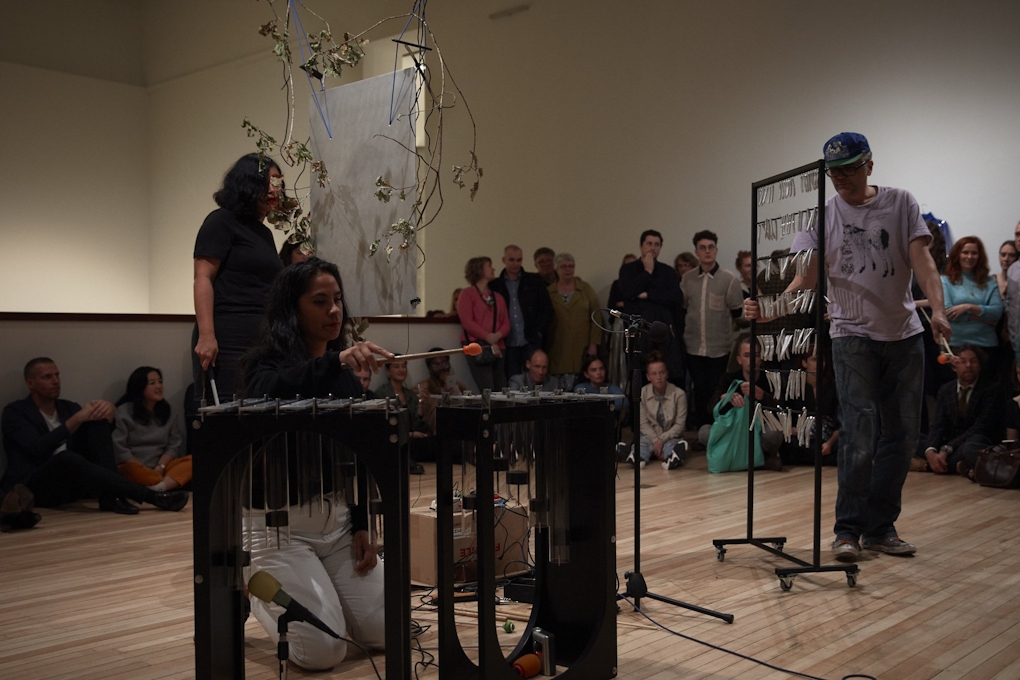
Performance: The Coolies, Govett-Brewster Art Gallery (2018). Photo by Sam Hartnett
In idiosyncratic details such as these, the show hints at beauty, but Spong deliberately prevents her audience from being too beguiled. The gorgeous watercolour paintings on the top floor—described as “sigils”, symbols that have magical powers—are painted in bright yellow food colouring, saffron, and honey. I wanted to get up close and see if this combination of materials had a smell, or if it coagulated on the paper in a certain, strange way. But the paintings are gated off. The work Design for a horse bit #2 (2018) stands in your way, a large ornate gate preventing access to the gallery. The works can only be viewed from far off, across a divide and from the vantage point of another, higher gallery. Spong creates beautiful objects and is obviously attracted to the suggestive potential of colour, but is simultaneously wary of this attraction; she said of this work—which again, is one in a series—that they are “beautiful by also about control and discipline”.(5)
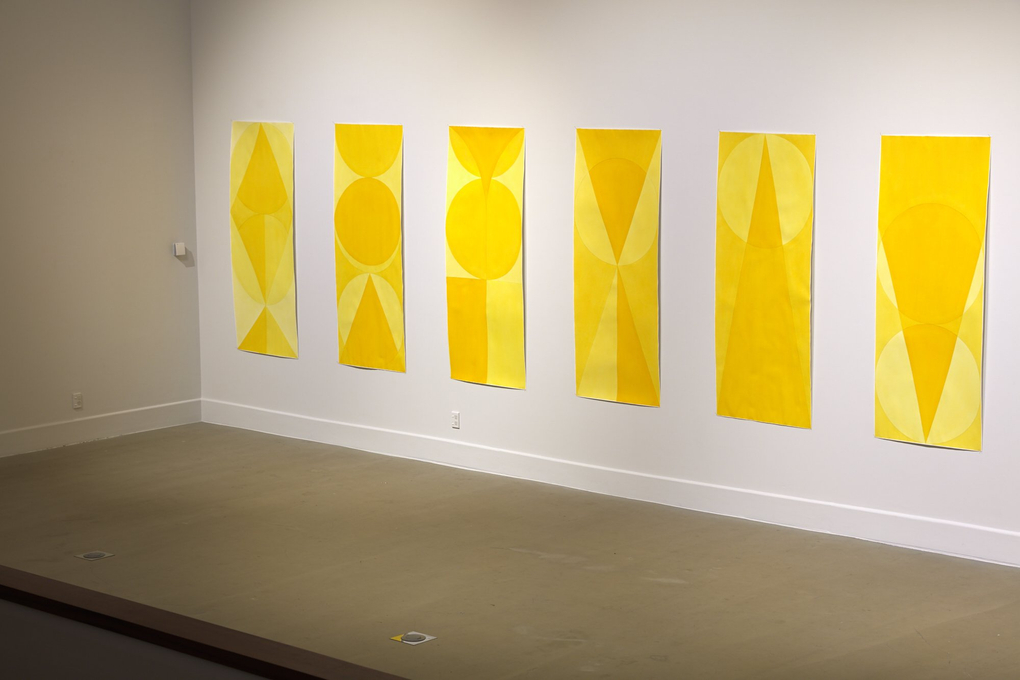
Installation view of a hook but no fish (2018) Sriwhana Spong, Govett-Brewster Art Gallery. Photo by Sam Hartnett
In November 2017, the New Plymouth District Council voted to establish an entry charge of $15 for all visitors to the gallery from outside of New Plymouth, a change that will be implemented in August of this year.(6) As such, it is an interesting moment for the Govett Brewster to stage this show, as a hook but no fish reveals its richness and references over time, and isn’t immediately accessible or spectacular or whacky in the way crowd-drawing contemporary art can be. I’ve been thinking and reading about the exhibition for several weeks and, for the purposes of review, have had access to the video works to re-watch online—which was important because they are both long and detailed and take time to think through. Serendipitously, I also came to the show having already been interested in Hildegard von Bingen for several years; I was a gallery goer pre-loaded with some historical context, and interested to see Spong’s response to Hildegard’s legacy. This exhibition requires more than a quick walk through. And it may be that we see a change in the Govett Brewster’s programming after the entry fee is established, to more populist exhibitions, which would be ironic given that the Govett’s brand, as promoted via their website and various other campaigns, is that of “provocateurs since 1970” a claim that is in some ways true, the gallery having been an important site for experimentation and exhibition in Aotearoa’s art history, even if this has been accompanied by the malcontent murmurings of New Plymouth’s city councilors.
This, however, is not Spong’s concern, and neither should it be. She has used her time as the Govett’s 2018 artist in residence to stage a big show, one full of ideas and questions about power and language and knowledge. Hildegard’s Lingua Ignota includes a few adjectives but is mostly nouns, a language only of names—this seems, in a way, defiant; a woman announcing and claiming space for herself in a world that did not recognise the brilliance and intellect of women. Moving from sculpture, to video, to painting, to performance, a hook but no fish, in its skepticism of language, digs away at how we know what we know, and is the work of an artist similarly bold.
